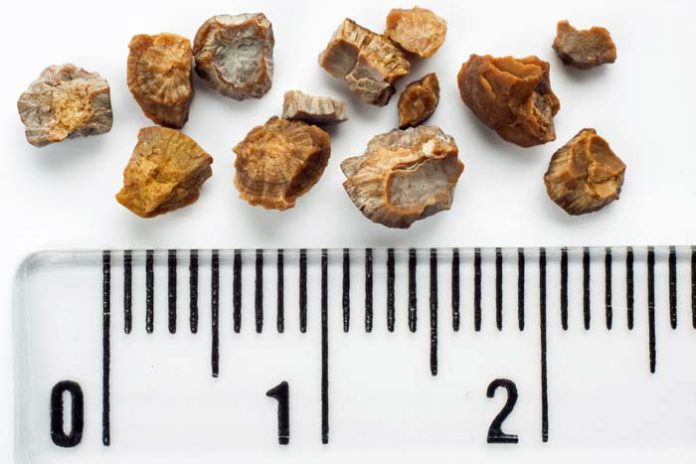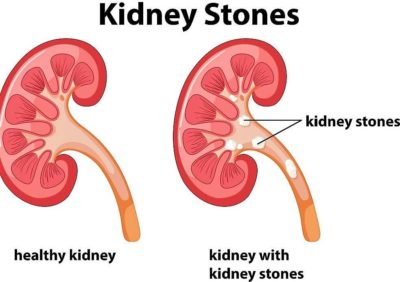Anthony Cleves, 57, hates water, dreads drinking it. In 2016, Anthony developed kidney stones, and it was the most pain he has endured in his entire life. Now, a just two years later, Anthony’s disdain for water has cost him yet another bout with kidney stones. “I can’t believe I am at this place again! I really try to drink water on a daily basis, but I just don’t like the taste. My negligence has landed me here, waiting to pass a stone and I am dreading it!”
One in ten people will suffer from kidney stones at some point in their lives. Eighty percent of sufferers are men, and the ailment is becoming increasingly more common among African Americans.
What are kidney stones?
A kidney stone is a pebble-like object made from chemical (calcium, oxalate, urate, cystine, xanthine, and phosphate) wastes in the urine. When there is too little liquid and too much waste in the urine, crystals form, and attract other elements to form a solid that will grow unless it is passed out of the body via urination. If a doctor properly treats the condition, they rarely cause permanent damage.
How are kidney stones diagnosed?
If a physician suspects kidney stones he may subject you to such diagnostic testing as:
Urinalysis: A 24-hour urine collection may reveal you are excreting too many stone-forming minerals or too few stone-preventing substances. You might be asked to take two urine collections over two straight days.
Blood tests: Blood work may reveal an excess of calcium or uric acid in your blood. The test can also give your doctor some clues about the overall health of your kidneys.
Imaging: Kidney stones may show up on an abdominal X-ray, ultrasound or CT scan that can spot minuscule stones. An intravenous urography involves injecting dye into an arm vein then X-raying, or obtaining CT films, as the dye travels through your kidneys and bladder.
Analysis of a passed stone: Your physician might ask you to urinate through a strainer to catch the stones you pass. A lab will then analyze your stones. The lab results will help your doctor put together a plan that might prevent you from developing future stones.
What are the kidney stone symptoms?
Sharp pains in your back, side, lower abdomen or groin
Pink, red, or brown blood in urine (hematuria)
Urgency to urinate
Painful urination
Inability to urinate or trickles
Cloudy or foul-smelling urine
Nausea
Vomiting
Fever and chills (if there’s an infection)
Kidney stone pain may be fleeting, last a while, or come and go.
What causes kidney stones?
There are a few factors that can increase your overall risk of developing kidney stones:
Dehydration: Failing to drink enough water every day can increase your risk of developing stones. Folks who live in hot climates sweat a lot might, and don’t stay hydrated also have a higher kidney stone risk than others.
Diet: A diet that is high in animal protein (beef, chicken, pork and organ meats), sodium, eggs, shellfish, dairy and sugar, may increase your risk of kidney stones. Restrict yourself from eating foods that are rich in oxalates. These include rhubarb, beets, okra, spinach, Swiss chard, sweet potatoes, nuts, tea, chocolate, black pepper, and soy products. Ask your doctor before taking calcium supplements, as these have been linked to increased risk of kidney stones. You may reduce kidney stone risk by taking supplements with meals. Diets low in calcium can increase kidney stone formation in some people.
Have a conversation with your doctor about your diet and kidney stone prevention.
Obesity: Being overweight can put you at risk for stones.
Digestive diseases and surgery: Gastric bypass, inflammatory bowel disease or chronic diarrhea can cause changes that can affect the body’s absorption of water and calcium leading to the formation of stones.
Other medical conditions: Cystinuria (high concentrations of the amino acid cysteine in the urine), hyperparathyroidism (excess of the hormone made by four small glands in the neck) and certain meds and some urinary tract infections can lead to stones.
There are four types of Kidney stones:
- Calcium stones are the most common and are made of calcium and oxalate (a chemical found in many foods), but are sometimes made of calcium and phosphate.
- Uric acid stones form when your urine is often too acidic. Uric acid can form stones by itself or with calcium.
- Struvite stones occur as the result of urinary tract infections in which bacteria makes ammonia that builds up in your urine. These stones are composed of magnesium, ammonium and phosphate.
- Cystine stones are rare and come from a chemical in your body called cystine.
Treatments for kidney stones
Most kidney stones will not require surgical require surgical removal. You might be able to pass a small stone by doing the following:
Drink water: Unless you have kidney failure, drinking at least 2 to 3 quarts of water per day may help get the stones out. Make sure to drink water and steer clear of sugary beverages. You should drink until your urine is practically clear.
Citrus juice: Though water is best, other liquids such as citrus drinks may also help prevent kidney stones. Some studies show that citrus drinks, such as lemonade and orange juice, protect against kidney stones because they contain citrate, which stops crystals from turning into stones.
Pain meds: Passing a small stone can be pretty uncomfortable, so your doctor may advise you to take either acetaminophen (Tylenol), ibuprofen (Advil, Motrin) or naproxen sodium (Aleve).
Medical intervention: Your physician may give you a drug that can help move that kidney stone out of your body known as an alpha-blocker which relaxes the muscles in your ureter. The medication helps to make the passing of the stone quick and less painful.
Larger stones are more problematic and usually cannot be treated with more conservative methods. A few more aggressive modes of treatments to remove large kidney stones include:
Sound waves to break up stones: Extracorporeal shock wave lithotripsy uses sound waves to create vibrations that break up stones small enough so that they can pass in your urine. The procedure is about 45 minutes, you might be given light sedation and it can cause moderate pain.
Surgery (percutaneous nephrolithotomy): Large stones are removed using telescopes and instruments inserted via your back. The procedure is under general anesthesia and requires a possible two-day hospital stay.
Scope removal: A doctor may use a thin, lighted, ureteroscope equipped with a camera and insert it through your urethra and bladder to your ureter to break the large stones so that they pass in your urine. General anesthesia is required for this procedure.
People with hyperparathyroidism, a condition that results in too much calcium in the blood, sometimes develop calcium stones. Treatment for hyperparathyroidism may include surgery to remove the abnormal parathyroid gland. Removing the parathyroid gland cures hyperparathyroidism and can prevent kidney stones. Surgery, however, sometimes causes infection.
After these procedures, sometimes the urologist may leave a thin flexible tube, called a ureteral stent, in your urinary tract to help urine flow or a stone to pass. Once the kidney stone is removed, your doctor sends the kidney stone or its pieces to a lab to find out what type it is.
As with any medical condition, it is crucial that you have a thorough discussion about your diagnosis and understand all that is being explained! Consider your doctor your partner in health care—someone who can discuss your situation with you, explain your options, and help you make decisions that are right for you.












